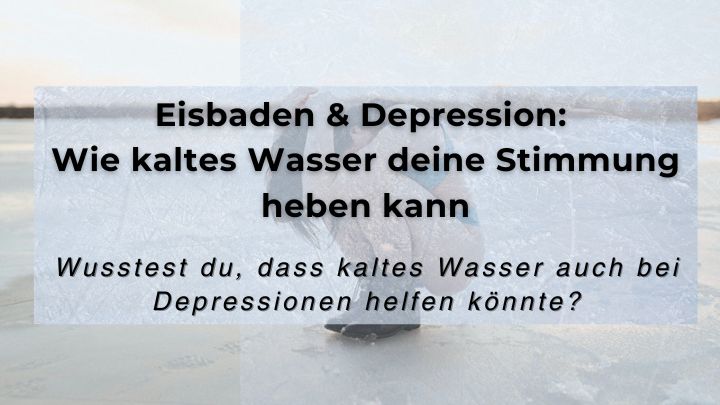
Ice bathing & depression: how cold water can lift your mood
Do you often feel listless, depressed or just not yourself? You may have heard of ice bathing - but did you know that cold water could also help with depression? In this blog, we take a look at what's really behind the trend - and how it might even help you.

What is ice bathing anyway?
In a nutshell: ice bathing involves exposing your body to cold water for a few minutes - usually between 10 and 15 °C. It sounds crazy, doesn't it? But this shock to the body seems to have amazing effects on the psyche.
Depression and the search for hope
Anyone who suffers from depression or severe mood swings knows the feeling: inner emptiness, listlessness, constant ups and downs. Often nothing really seems to help. In addition to therapy and medication, many people look for additional ways to stabilize their psyche.
One approach that has received more and more attention in recent years is ice bathing. But how exactly can cold water dispel the dark clouds in your head?
When your mood is on a rollercoaster
Depression is not simply "sadness". It affects the whole person: Thoughts, feelings, body and everyday life. Frequent companions are
- deep listlessness
- Mood swings that are difficult to control
- Ruminations and negative thinking
- Physical complaints such as tiredness, sleep disorders or pain
This is what makes it so difficult to break out on your own. Any support that clears the fog, even briefly, is therefore precious.
Why cold water can affect the psyche
The special thing about ice bathing in connection with depression and low moods is that it has a direct effect on our nervous system.
- Acute mood boost: Just a few minutes in cold water can significantly raise dopamine levels. Many people report that they feel clearer, lighter and more positive afterwards - at least for a few hours.
- Interrupting negative thought spirals: The moment your body is immersed in ice water, there is no room for brooding. Your focus is entirely on breathing and body awareness. This "back to the now" can be a valuable break from the constant circling of thoughts.
- Stabilizing mood swings: People with depression are familiar with extreme ups and downs. Regular cold stimuli can train the nervous system to deal better with stress and internal fluctuations - like a kind of reset button.
Studies: what does science say?
Research is still in its infancy, but initial results are promising:
- A study in Medical Hypotheses (2018) describes cold showers as a possible complementary therapy for depression, as they can influence brain activity in a similar way to mild electrical stimulation.
- Shevchuk, N.A. (2008). Adapted cold shower as a potential treatment for depression.
- The neuroscientist Dr. Andrew Huberman explains that cold exposure significantly increases dopamine levels in the brain for hours - a possible reason why sufferers feel a "clear head" after ice bathing.

Testimonials: small rays of hope in everyday life
Many sufferers report positive effects - even if ice bathing does not cure depression.
- "After Cold plunge, I feel like I've flipped a switch. The fog in my head is gone - even if only for a few hours."
- "I feel like I at least have a tool to combat my low moods. That gives me hope."
These moments may be small, but they can make a big difference when life is filled with darkness.

Boundaries: What ice bathing can't do
As helpful as ice bathing can be, it is important to be clear about boundaries:
- It is not a substitute for psychotherapy or medication.
- Depression is a serious illness that requires professional support.
- Some people (e.g. with heart problems) should only try cold exposure after consulting a doctor.
Ice bathing is best seen as a supplement: a tool that can provide additional strength and stability.
Practical tips for people with mood swings
If you want to start ice bathing, especially to stabilize your mood, take note
:- Start small: Cold showers for 20-30 seconds is a good start.
- Regularly instead of extremely: It's better to do it briefly 2-3 times a week than infrequently and for too long.
- Keep a mood diary: Note how you feel before and after the cold. This motivates you and shows progress.
- Listen to your body: If you feel overwhelmed or anxious, stop. Pressure does not help.
- Seek support: It's easier together - perhaps in a group or with friends.

Frequently asked questions (FAQs)
► Is ice bathing dangerous?
Not if you do it right. The important thing is to build up slowly, watch your body and never overdo it.
► Can I do the Wim Hof method without ice bathing?
Yes! The breathing technique alone has many positive effects - cold is an optional but effective extra.
► How often should I ice bathe?
One to three times a week is enough for many people. Regularity is important, not extremism.
► What should I wear for ice bathing?
Nothing - or swimwear. The important thing is to have dry, warm clothes ready afterwards.
Conclusion: a small glimmer of hope
Depression and mood swings are difficult and often overwhelming. Ice bathing is not a panacea - but it can make a small, valuable difference.
It provides moments of clarity, glimpses of light in the dark and the feeling: I have something in my hands.
If you are struggling with depression, a step into cold water could be a step back into life - gentle, complementary and full of hope.
Did you like this article or did it help you?
Feel free to share it with friends - or ask us your questions in the comments below or by email.
See you soon in your own wellness oasis! 💙







Leave a comment